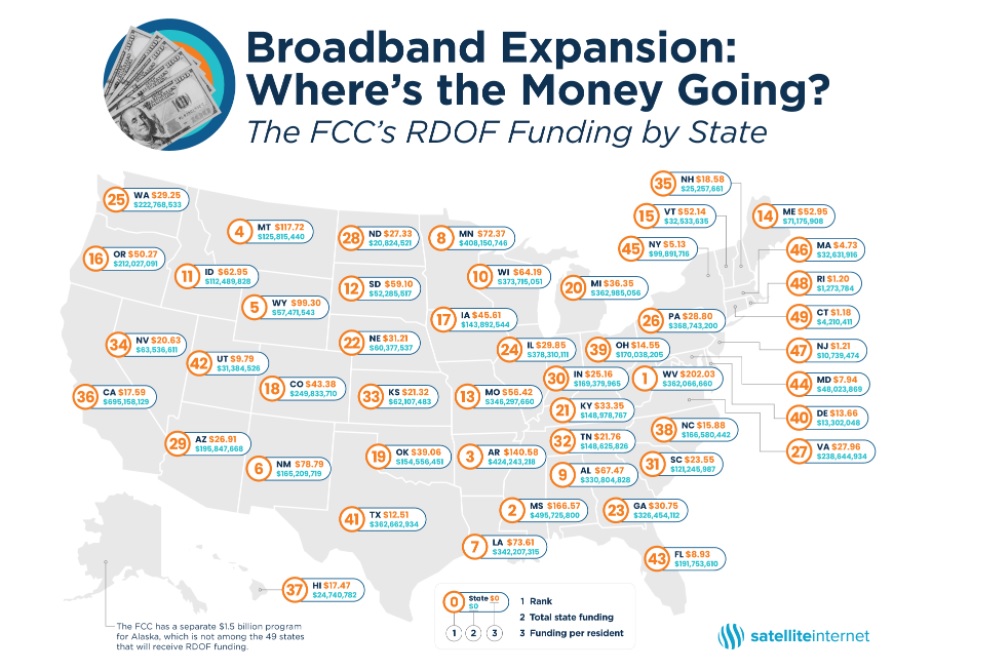Analysis: California Tops RDOF Bucks Per Rural Resident
Rhode Island brings up rear

All the gold in California isn't in Beverly Hills banks. Some of it is in the FCC's multi-billion-dollar rural broadband subsidy fund.
Rural residents in California got the most money for broadband in the FCC's recent Rural Digital Opportunities Fund (RDOF) auction at $830 per resident, while Rhode Island got the least with only $9.
That is according to Satelliteinternet.com, which analyzed Phase 1 of the fund outlay comparing FCC dollar figures with Census Bureau data on residents in general and rural residents in particular given that it is a rural broadband subsidy program.
West Virginia was second most at $530, followed by Arkansas with $377, Minnesota with $328, and Massachusetts with $327. Among the lowest, New Jersey was second at $13 per rural resident, Connecticut third least at $23, followed by New Hampshire with $50 per rural resident and North Dakota, $53.
Also Read: FCC's Rural Broadband Subsidy Bidding Begins
The FCC has said that winning bidders in its RDOF Phase I auction have the money to deploy high-speed broadband to more than 5.2 million unserved homes/businesses (5,220,833 to be specific), which it said was almost 99% of the available locations in the auction.
The auction allocated $9.2 billion for rural broadband buildouts over the next 10 years. it has buildout requirement, including reaching all assigned locations completed by the end of year six, but incentives to build out all locations ASAP.
The smarter way to stay on top of the multichannel video marketplace. Sign up below.
While service of at least the FCC's 25 mbps upstream/3 mbps downstream high speed definition was eligible for the money, the FCC prioritized bids for higher speeds and lower latency.
Also Read: Charter Wins Most RDOF Buildout Locations
Somewhat surprisingly, North Dakota got some of the least funding per rural resident--$53.73--even though almost 40% of the state's population is rural.
The analysis found that Maryland ranks as one of the states with the least funding per resident (rural and non-rural), even though one in four of those residents lacks a home wireline broadband connection, with African Americans representing 40% of those unconnected households.
South Dakota, which has some of the slowest average internet speeds, says Satellite Internet, and a large rural population, ranks among the lowest in overall funding.
The national average for funding per resident (rural and nonrural) was $37.03.
Below are the top and bottom 10 states in terms of dollars per rural resident:
Top 10 funded states: funding per rural resident
California: $830
West Virginia: $530
Arkansas: $377
Minnesota: $328
Massachusetts: $327
Mississippi: $313
Pennsylvania: $254
Wisconsin: $248
Michigan: $201
Illinois: $205
Least funded states: funding per rural resident:
Rhode Island: $9
New Jersey: $13
Connecticut: $23
New Hampshire: $50
North Dakota: $53
Delaware: $73
Vermont: $80
Hawaii: $90
Utah: $93.30
Texas: $117
Satellite Internet's report included a Spoiler Alert: "[L]ooks like some states got a fair amount, others are getting shortchanged, and a few scored more than seems fair (looking at you, California)."
Contributing editor John Eggerton has been an editor and/or writer on media regulation, legislation and policy for over four decades, including covering the FCC, FTC, Congress, the major media trade associations, and the federal courts. In addition to Multichannel News and Broadcasting + Cable, his work has appeared in Radio World, TV Technology, TV Fax, This Week in Consumer Electronics, Variety and the Encyclopedia Britannica.

